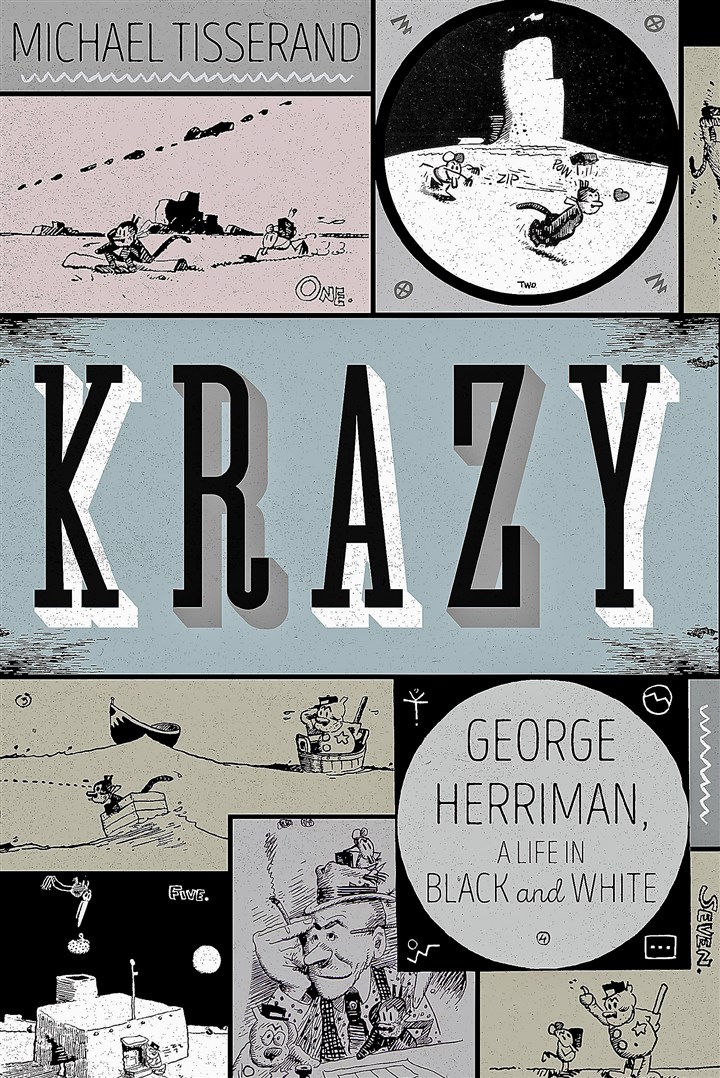Krazy: George Herriman, A Life in Black and White by Michael Tisserand (review)
Inks: The Journal of the Comics Studies Society
Volume 1, Issue 1, Spring 2017
pages 117-120
Christopher Jeansonne, University Fellow, Graduate Teaching Associate
Department of Arts Administration, Education and Policy
Ohio State University
Michael Tisserand, Krazy: George Herriman, A Life in Black and White. Harper, 2016. 550 pp, $35.
Michael Tisserand’s Krazy: George Herriman, a Life in Black and White, a work of passion and sagacity, not only gives a comprehensive overview of Herriman’s oeuvre but insightfully situates it in personal and socio-cultural context. Krazy Kat is perhaps one of the most lauded newspaper comic strips of all time, and yet this is the first book-length biography of its creator. Nine years in the making, Tisserand’s book has been much anticipated by scholars and fans of the artist. As suggested by the double meaning of the title, Tisserand argues that an awareness of Herriman’s complex racial background is central to reading both Herriman’s life and his work. Herriman was listed as “col.” (or “colored”) on his New Orleans birth certificate and “Caucasian” on his California death certificate—and these two arbitrary classifications form the frame to Tisserand’s study.
Tisserand’s prose has a lively clarity learned from a career working extensively as a journalist, and this comprehensive biography will certainly be sought out by both academic and lay audiences interested in newspaper comics, or comics in general. As an exhaustive historical account of Herriman’s life, it will be an indispensable resource for scholars working in sequential art; thanks to Tisserand’s meticulous research, even those deeply familiar with Krazy Kat will cull new insights from the details he has unearthed. Perhaps most importantly, this comprehensive and nuanced account of Herriman’s life and work in parallel in a single volume reveals new depths to the “komplexities” of the Krazy Kat with whose challenges many of us thought we had already grappled.
Part 1, “Watta Woil,” opens with an account of the posthumous uncovering of Herriman’s ambiguous racial heritage by scholars in the 1970s, and the debates that ensued: How reliable was this information? To what degree was Herriman aware of his racially mixed background? What is the relevance of racial identity for understanding Herriman’s work? Tisserand ends the opening chapter with a question that resonates throughout the rest of the book: “Did this revelation, whatever it was, find its way into his wondrous comics? Is it a source of the wonder?” Tisserand then describes in detail the complicated web of Herriman’s mixed-race ancestry and the challenges his ancestors faced during the post-Civil War and Jim Crow eras; some of the most powerful moments in this section are provided by the concrete, personal, and tragic features of the racist and reactionary post-slavery Deep South. These challenges finally led to his parents’ decision to move to California and pass as white. Throughout the remainder of Part 1, we follow Herriman’s early life and schooling, and his budding interest in a life of drawing comics—opportunities, Tisserand notes, that he may not have had as a “colored” youth in the New Orleans of the time.
Part 2, “The Greek,” traces Herriman’s development as a professional cartoonist. For many hectic years he lived like a bi-coastal yo-yo, moving from Los Angeles to New York and back again as he switched jobs from newspaper to newspaper. He worked in the macho world of first-generation newspaper comics, with cartooning greats such as Tad Dorgan and Jimmy Swinnerton, building a name for himself with his inventive sports and political comics even as he struggled to find an audience for his numerous daily strip comic ideas. In this period Herriman’s work became increasingly concerned with social pretense, language, and mistaken or fluid identities, and central motifs such as minstrelsy began to take hold. While careful to note that “at times his comics did not rise above the ugly stereotypes of the day,” Tisserand also provides insightful readings of the ways Herriman was already challenging racism and complicating notions of racial identity even in his early comics (188). Particularly memorable are Tisserand’s passages on the “impussanations” from Herriman’s short-lived Musical Mose strip (in which a black musician poses as a Scotsman), and his cartoon coverage of interracial boxing matches, most notably…

